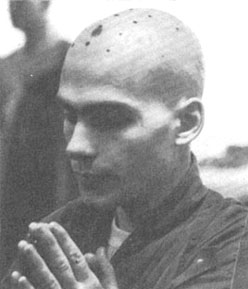|
Ananda once told Shakyamuni Buddha that surely 50% of the
holy life was in finding good friends. The Buddha said, "You're wrong,
Ananda. Good friendship is 100% of the holy life." The truth of this
principle was proven when the Wilczak family moved to the quiet suburbs of Elk
Grove, Illinois. Back from military academy, Gregory again fell in with bad
companions and began a slow slide into his old habits. When he turned eighteen,
however, his life changed again--another budding interest turned his energies
away from self-destructive behavior and towards the study of mystical religions,
particularly Buddhism. Putting the principles he read about into actual
practice, he quickly renounced smoking, lying, and running with friends to drink
and look at girls. His nature grew pensive, withdrawn, and he used his time to
study and contemplate Eastern truths. Casting about for direction, Gregory spent
six months in a university while working at this point he was struck by the
inspiration to follow series of jobs in hospitals and department stores. At his
heart's desire and investigate Buddhism in a country where it actually was
practiced. Sri Lanka's Buddhist Publication Society suggested that he go to
Bangkok, Thailand, and to the king's temple Wat Bovornivet, and so in April,
1975, after saving money for the journey, that's what he did.
Along with other Westerners at Wat Bovornivet, Gregory
studied the Abhidharma and lived the life of a monastic. When his quota of visa
extensions expired after three months he had to decide whether to become a monk
or to return home.
"I loved Buddhism very much but I had a conflict.
I'm an American and Thailand is a foreign land. The language and cultural
differences were hard to manage, yet Thailand is a Buddhist country while my
native land isn't. Ultimately, I decided to return home. As soon as I walked
through the door of my parents' house I realized I had made a mistake and I
should have become ordained while I had the chance."
Within six months Gregory found himself back in Bangkok
and three months later, he donned the robes of a Sramanera, or novice, thereby
realizing the ambition of a lifetime. The English-speaking monks at the temple
taught him the lessons of small-vehicle Buddhism, the Vinaya, Theravadin sutras,
and the Abhidharma. At this time another of those transitions occurred that
figure strongly in Heng Shun's life. His small-vehicle Buddhist orientation was
completely shattered when he read in the Lotus Sutra that everyone can
and will become a Buddha. This teaching of the Great Vehicle captivated his
being--he corresponded with a fellow Sramanera who had disrobed and gone to
Korea to practice the Mahayana Way, and he began to make the necessary travel
arrangements to follow him. On the verge of his departure he found the most
compelling book he had ever seen: the biography of the Venerable Dhyana Master
Hua.
"With a single reading, I knew the Master was my
teacher, the feeling was that strong. I had never recognized anyone as my
teacher before, and being conceited, I thought I didn't need one. But after
reading about this master I faced the East and bowed to him one thousand times
in the morning and one thousand times in the evening for four days straight. I
wrote to my friend in Korea and told him my plans had changed; I was going to
Gold Mountain in San Francisco instead."
"In June of 1974, I disrobed, bought a plane ticket
to San Francisco, and changed my diet to eat only vegetarian food. I arrived at
Gold Mtn. but only stayed a week the first time. To truly cultivate the Way as
people do here is not an easy matter and frankly, I was caught off-balance,
chickened-out, and ran home."
At his parents' home in Elk Grove he set up an
altar to the Master and read many books on Mahayana Buddhism. His interest in
the Avatamsaka Sutra, which he had heard being lectured during his visit to the
Monastery, was heightened by D.T. Suzuki's description of the book as one of the
greatest religious works in the world, telling about the nature of the universe,
the way it actually is.
Wanting to hear more of the
Avatamsaka and responding to
the irresistible attraction he felt towards the Master, he returned to the Gold
Mtn. summer session of August, 1974. During the next twelve months he left the
monastery only in his official capacity of temple properties manager. He used
all his remaining time in vigorous cultivation of the Mahayana Buddhadharma. On
August 24, 1975, with his parents in attendance at the ceremony, Gregory Wilczak
received the ten precepts of a novice in the orthodox Great Vehicle tradition
and became from that day forth, Sramanera Heng Shun, left home disciple of the
Venerable Master Hua.
Heng Shun strictly holds the 58 Bodhisattva precepts; he
is a tireless worker, cheerfully taking on the jobs that no one else wants to
do. He eats only one meal a day and has vowed to eat no more than one bowl of
food per meal. He cultivates the practice of sitting up at night and never lies,
down to sleep. With cultivation as vigorous as his Sramanera Heng Shun will
quickly bring to magnificent blossom that fragrant lotus that began growing
years ago in the mud of Chicago's West Side.
|
